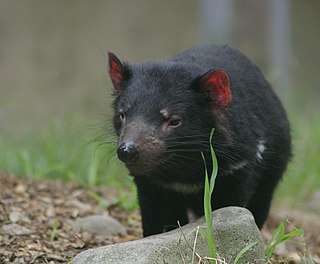
The Dasyuridae are a family of marsupials native to Australia and New Guinea, including 71 extant species divided into 17 genera. Many are small and mouse-like or shrew-like, giving some of them the name marsupial mice or marsupial shrews, but the group also includes the cat-sized quolls, as well as the Tasmanian devil. They are found in a wide range of habitats, including grassland, underground, forests, and mountains, and some species are arboreal or semiaquatic. The Dasyuridae are often called the 'marsupial carnivores', as most members of the family are insectivores.
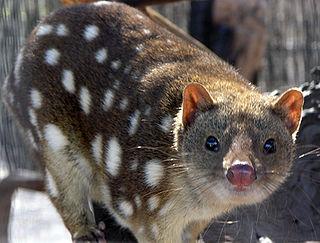
The subfamily Dasyurinae includes several genera of small carnivorous marsupials native to Australia: quolls, kowari, mulgara, kaluta, dibblers, phascogales, pseudantechinuses, and the Tasmanian devil. The subfamily is defined largely on biochemical criteria.

The dibbler is an endangered species of marsupial. It is an inhabitant of the southwest mainland of Western Australia and some offshore islands. It is a member of the order Dasyuromorphia, and the only member of the genus Parantechinus. The dibbler is a small, nocturnal carnivore with speckled fur that is white around the eyes.
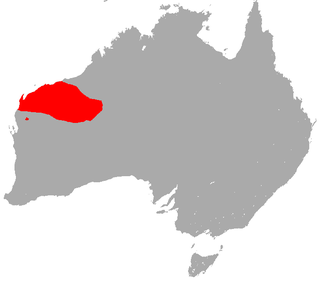
The little red kaluta is a small, reddish-brown, shrew-like mammal native to dry grasslands of northwest Western Australia. It is active at night, feeding on insects and other small animals. The kaluta is a marsupial and is the only member of its genus, Dasykaluta. Individuals are around 10 cm (3.9 in) long and weigh from 20 to 40 g. They live for about four years in captivity. Other common names include little red antechinus, russet antechinus and spinifex antechinus.

The tribe Dasyurini includes several genera of small carnivorous marsupials native to Australia: quolls, kowari, mulgara, kaluta, dibblers, neophascogales, pseudantechinuses, and the Tasmanian devil.
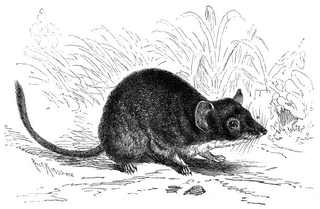
The Phascogalini are a tribe in the family Dasyuridae, comprising seven genera of small marsupials native to Australia and New Guinea.

The fat-tailed false antechinus, also called the fat-tailed pseudantechinus and red-eared antechinus, is a member of the order Dasyuromorphia. It is an inhabitant of western and central Australia. Its species name, macdonnellensis, refers to the MacDonnell Ranges near Alice Springs, where it was first discovered.
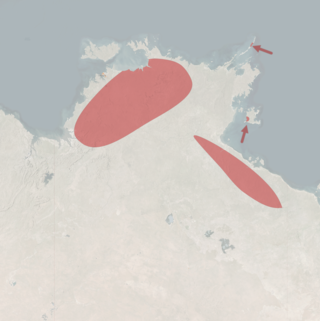
The sandstone false antechinus, also known as the sandstone pseudantechinus, the sandstone antechinus, the sandstone dibbler, Harney's antechinus and the Northern dibbler, is a species of small carnivorous marsupial, which has a patchy distribution in Australia's Northern Territory.

The Alexandria false antechinus, also known as the Carpentarian false antechinus or Carpentarian pseudantechinus, is a small carnivorous marsupial, found only in a number of small, isolated localities in northern Australia. It is the smallest and rarest of the false antechinuses.
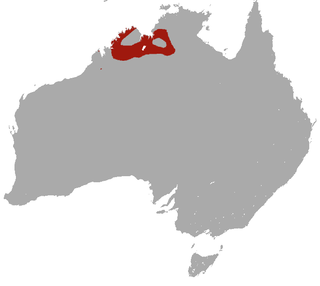
The Ningbing false antechinus, also known as the Ningbing pseudantechinus, is a small species of carnivorous marsupial found in north-western Australia. It is locally common throughout the Kimberley region of Western Australia and the Northern Territory.

Woolley's false antechinus, also known as Woolley's pseudantechinus, is a species of small carnivorous marsupial belonging to the family Dasyuridae. It is found in the Australian state of Western Australia, primarily in the Pilbara, Ashburton and Murchison regions.

Rory Cooper's false antechinus, also known as the tan false antechinus and the tan pseudantechinus, is a recently named species of small carnivorous marsupial which inhabits rocky outcrops in Western Australia. Nothing is known of its behaviour but it is expected that this will be similar to other members of the false antechinus genus. A study published in 2017 found no support for separation as a new species of Pseudantechinus, and the name was proposed to be synonymous with the previously described Pseudantechinus macdonnellensis.
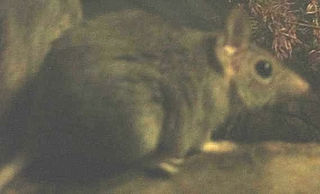
The fawn antechinus is a species of small carnivorous marsupial found in northern Australia. It is the only Antechinus to be found in the Northern Territory and has a patchy, restricted range.

The Atherton antechinus, also known as Godman's antechinus, is a species of small carnivorous, insectivorous marsupial native to Australia. It is one of the rarest members of its genus, and differs from other antechinuses in its more rufous body colour and small eyes.
Patricia Woolley is an Australian zoologist recognised for her work with marsupials, specifically the dasyurid family. Pseudantechinus woolleyae is named for her.













